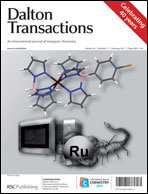New square-pyramidal bis(ene-1,2-dithiolate)MoSe complexes, [MoIVSe(L)2]2−, have been synthesised along with their terminal sulfido analogues, [MoIVS(L)2]2−, using alkyl (LC4H8), phenyl (LPh) and methyl carboxylate (LCOOMe) substituted dithiolene ligands (L). These complexes now complete three sets of MoIVO, MoIVS and MoIVSe species that are coordinated with identical ene-1,2-dithiolate ligands. The [alkyl substituted Mo(S/Se)(LC4H8)2]2− complexes were reported in prior investigations (H. Sugimoto, T. Sakurai, H. Miyake, K. Tanaka and H. Tsukube, Inorg. Chem. 2005, 44, 6927, H. Tano, R. Tajima, H. Miyake, S. Itoh and H. Sugimoto, Inorg. Chem. 2008, 47, 7465). The new series of complexes enable a systematic investigation of terminal chalcogenido and supporting ene-1,2-dithiolate ligand effects on geometric structure, electronic structure, and spectroscopic properties. X-ray crystallographic analysis of these (Et4N)2[MoEL2] (E = terminal chalocogenide) complexes reveals an isostructural Mo centre that adopts a distorted square pyramidal geometry. The M![[triple bond, length as m-dash]](https://www.rsc.org/images/entities/char_e002.gif) E bond distances observed in the crystal structures and the ν(M
E bond distances observed in the crystal structures and the ν(M![[triple bond, length as m-dash]](https://www.rsc.org/images/entities/char_e002.gif) E) vibrational frequencies indicate that these bonds are weakened with an increase in L→Mo electron donation (LCOOMe < LPh < LC4H8), and this order is confirmed by an electrochemical study of the complexes. The 77Se NMR resonances in MoSeL complexes appear at lower magnetic fields as the selenido ion became less basic from MoSeLC4H8, MoSeLPh and MoSeLCOOMe. Electronic absorption and resonance Raman spectroscopies have been used to assign key ligand-field, MLCT, LMCT and intraligand CT bands in complexes that possess the LCOOMe ligand. The presence of low-energy intraligand CT transition in these MoELCOOMe compounds directly probes the electron withdrawing nature of the -COOMe substituents, and this underscores the complex electronic structure of square pyramidal bis(ene-1,2-dithiolate)-MoIV complexes that possess extended dithiolene conjugation.
E) vibrational frequencies indicate that these bonds are weakened with an increase in L→Mo electron donation (LCOOMe < LPh < LC4H8), and this order is confirmed by an electrochemical study of the complexes. The 77Se NMR resonances in MoSeL complexes appear at lower magnetic fields as the selenido ion became less basic from MoSeLC4H8, MoSeLPh and MoSeLCOOMe. Electronic absorption and resonance Raman spectroscopies have been used to assign key ligand-field, MLCT, LMCT and intraligand CT bands in complexes that possess the LCOOMe ligand. The presence of low-energy intraligand CT transition in these MoELCOOMe compounds directly probes the electron withdrawing nature of the -COOMe substituents, and this underscores the complex electronic structure of square pyramidal bis(ene-1,2-dithiolate)-MoIV complexes that possess extended dithiolene conjugation.
![[triple bond, length as m-dash]](https://www.rsc.org/images/entities/char_e002.gif) E and ene-1,2-dithiolate substituent effects on geometric and electronic structure†
E and ene-1,2-dithiolate substituent effects on geometric and electronic structure† ![[triple bond, length as m-dash]](https://www.rsc.org/images/entities/char_e002.gif) E bond distances observed in the crystal structures and the ν(M
E bond distances observed in the crystal structures and the ν(M![[triple bond, length as m-dash]](https://www.rsc.org/images/entities/char_e002.gif) E) vibrational frequencies indicate that these bonds are weakened with an increase in L→Mo electron donation (LCOOMe < LPh < LC4H8), and this order is confirmed by an electrochemical study of the complexes. The
E) vibrational frequencies indicate that these bonds are weakened with an increase in L→Mo electron donation (LCOOMe < LPh < LC4H8), and this order is confirmed by an electrochemical study of the complexes. The ![Graphical abstract: Chalcogenidobis(ene-1,2-dithiolate)molybdenum(iv) complexes (chalcogenide E = O, S, Se): Probing Mo [[triple bond, length as m-dash]] E and ene-1,2-dithiolate substituent effects on geometric and electronic structure](/en/Image/Get?imageInfo.ImageType=GA&imageInfo.ImageIdentifier.ManuscriptID=C0DT00871K&imageInfo.ImageIdentifier.Year=2011)

 Please wait while we load your content...
Please wait while we load your content...
![[triple bond, length as m-dash]](https://www.rsc.org/images/entities/h2_char_e002.gif) E and ene-1,2-dithiolate substituent effects on geometric and electronic structure
E and ene-1,2-dithiolate substituent effects on geometric and electronic structure